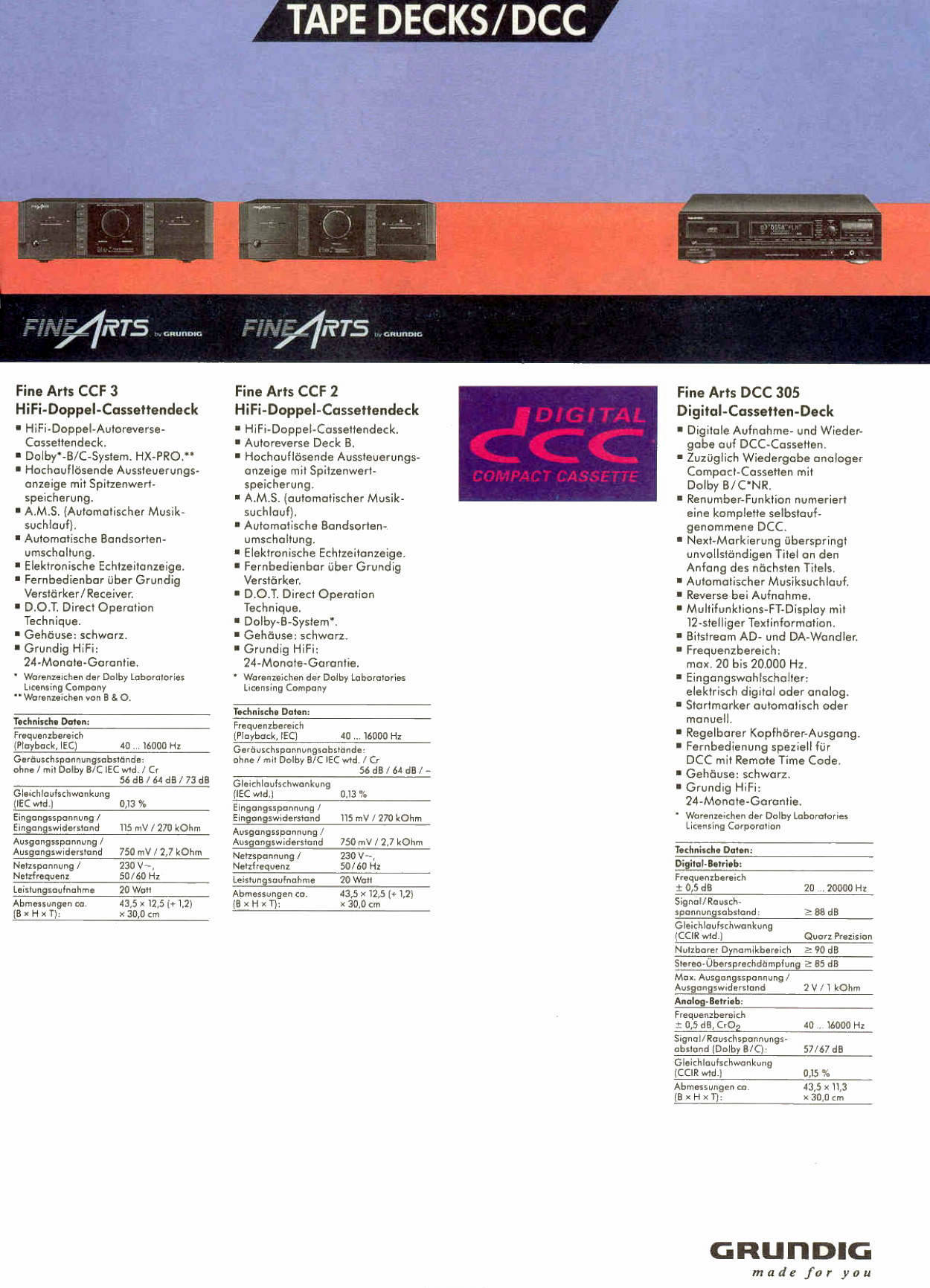Difference between revisions of "Grundig Fine Arts DCC 305"
(Die Seite wurde neu angelegt: „__NOTOC__ == Daten == {{Navigation}} '''Allgemein''' * Hersteller: Grundig * Modell: Fine Arts DCC 305 * Typ: Digital Kassetten Tape Deck * Baujahre: 1992…“) |
(→Daten) (Tags: mobile edit, mobile web edit) |
||
| (3 intermediate revisions by 3 users not shown) | |||
| Line 1: | Line 1: | ||
__NOTOC__ | __NOTOC__ | ||
| − | == | + | == Data == |
| − | {{ | + | {{navigation}} |
| − | ''' | + | '''General''' |
| − | * | + | * Manufacturer: [[Grundig]], OEM product Philips |
| − | * | + | * Model: Fine Arts DCC 305 |
| − | * | + | * Type: Digital Cassette Tape Deck |
| − | * | + | * Years of manufacture: 1992 - 1994 |
| − | * | + | * Manufactured in: |
| − | * | + | * Color: Black |
| − | * | + | * Original price approx.: 1'198 DM |
| − | ''' | + | '''Technical data''' |
| − | [[ | + | [[File:Grundig Fine Arts CCF 2-3-DCC-305-Prospekt-1993.jpg]] |
| − | + | == Remarks == | |
| − | == | + | * Other models in the Fine Arts series: |
| − | * | + | * DCC deck: |
| − | * DCC | ||
* [[Grundig Fine Arts DCC 305]] | * [[Grundig Fine Arts DCC 305]] | ||
| Line 32: | Line 31: | ||
| − | == | + | The DCC system, originally developed by Philips, was intended to combine digital recording technology with existing analog music carriers (compact cassette). The old analogue cassettes could also be played on these devices - but not recorded! At that time there were, |
| + | similar to the VCR systems at the end of the seventies, there was a battle of technologies or their involved companies. Philips and their subsidiaries Marantz and Grundig supported their own DCC system. Sony developed the digital MiniDisc. Other companies continued to support the already well-known DAT system. In addition, the first developments in the area of the recordable compact disc (CD) were already taking place. This development was just pushed by the PC area, where the CD-ROM was already used. The main problem with the introduction of new digital recording media was the dispute over copy protection or binding copying standards. This problem already occurred with the introduction of DAT and finally led to the SCMS copy protection. This limited digital copying to only one direct copy of the original recording. Both DCC and MiniDisc were not contactless and thus wear-free recording or playback media. | ||
| + | |||
| + | == Pictures == | ||
| − | == | + | == Reports == |
| Line 41: | Line 43: | ||
| − | [[ | + | [[Category:DCC Recorder]] |
Latest revision as of 04:53, 15 March 2021
Data[edit]
General
- Manufacturer: Grundig, OEM product Philips
- Model: Fine Arts DCC 305
- Type: Digital Cassette Tape Deck
- Years of manufacture: 1992 - 1994
- Manufactured in:
- Color: Black
- Original price approx.: 1'198 DM
Technical data
Remarks[edit]
- Other models in the Fine Arts series:
- DCC deck:
- Grundig Fine Arts DCC 305
- Tape Deck:
- Grundig Fine Arts CCF 2
- Grundig Fine Arts CCF 3
- Grundig Fine Arts CF 1
- Grundig Fine Arts CF 4
- Grundig Fine Arts CT-905
- Grundig Fine Arts CCT-903
The DCC system, originally developed by Philips, was intended to combine digital recording technology with existing analog music carriers (compact cassette). The old analogue cassettes could also be played on these devices - but not recorded! At that time there were,
similar to the VCR systems at the end of the seventies, there was a battle of technologies or their involved companies. Philips and their subsidiaries Marantz and Grundig supported their own DCC system. Sony developed the digital MiniDisc. Other companies continued to support the already well-known DAT system. In addition, the first developments in the area of the recordable compact disc (CD) were already taking place. This development was just pushed by the PC area, where the CD-ROM was already used. The main problem with the introduction of new digital recording media was the dispute over copy protection or binding copying standards. This problem already occurred with the introduction of DAT and finally led to the SCMS copy protection. This limited digital copying to only one direct copy of the original recording. Both DCC and MiniDisc were not contactless and thus wear-free recording or playback media.
